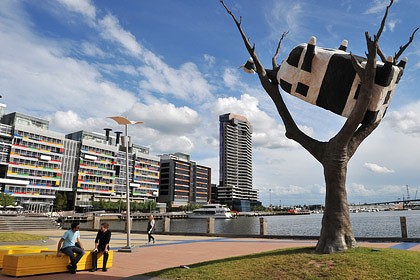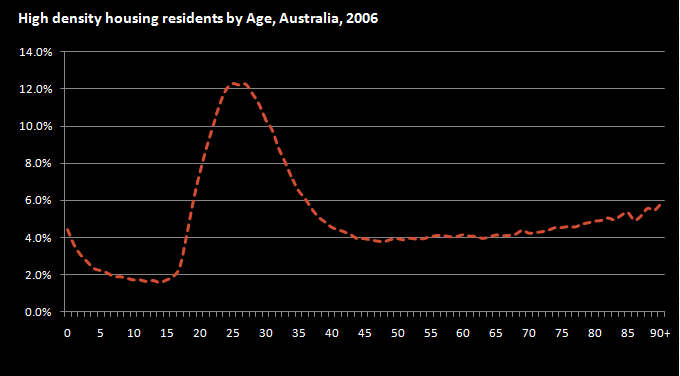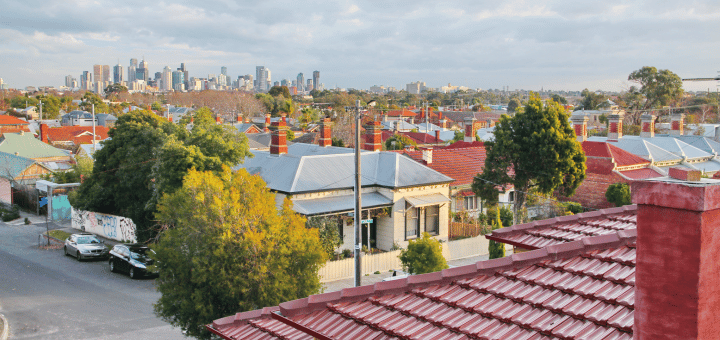A common demographic stereotype these days is that suburban empty nesters, whose children have finally left home, are downsizing into the inner parts of our cities, particularly being attracted to large apartment developments such as Docklands in Melbourne or Darling Harbour in Sydney. This leads to articles such as Domain’s “Downsizers feeling the squeeze” about the price expectations of empty nesters moving from the suburbs. But how realistic is this? For the most part, our inner cities are the domain of young people, so what does Census data show about where those over 65 are moving, and who is living in those inner city apartments?

As .id’s population profiles, such as this one for the City of Sydney, show, inner cities disproportionately house the young. With large tertiary education facilities nearby, ready access to employment, lots of rental accommodation and the lifestyle attraction of the “bright lights”, they are all set up for people in their 20s.
In fact, migration charts show that for inner city areas, people move in at 18-24 and move out in their 30s, when they start to have children. Our inner cities mainly comprise small 1-2 bedroom apartments, not considered suitable in Australia for families. There are some exceptions where families are living in high density, but they are mainly in suburban centres with a lot of apartments, and cater for those born overseas, such as Bankstown – see Ivan Motley’s article “Is there a market for family-style apartment living in Australia?“.
See the migration charts for the inner suburban LGAs of Port Phillip, Yarra, Sydney, Waverley, Adelaide and Subiaco – all show gain of youth, loss of families, and much lower levels of population movement for over 55s, with some having small gains and others small losses.
Generally, our inner cities feature high density accommodation, while families prefer separate houses. It may seem logical that after children leave home, empty nesters want to downsize, but downsizing may not always be an option. Ability and motivation to downsize can be affected by the high cost of moving, the increasing numbers of children coming back to live with their parents, and a lack of local downsizing options where empty nesters can maintain a connection to the local community.
Generally, propensity to live in medium and high density housing in Australia peaks among those in their 20s, declines through 30s and 40s and starts to increase again in the 50s. It is only once you get to 85+ that proportions of people living in dwelling types other than separate houses again reaches the peak of 25 year olds.

The interesting thing is that if you separate this into “medium density” (townhouses, villa units and 1-2 storey blocks of flats) and high density (3+ storey blocks of flats), you find that there is very little propensity to move into high density as you get older, but a strong propensity to move to medium density. Now some of this will be affected by the fact that most retirement villages appear in the data as medium density villa units, but it’s also interesting that the high density housing which typifies Australia’s inner cities really isn’t favoured by the elderly to any great extent, with proportions of over 65s in high density only around 5% of the population.
Maybe this is an accessibility issue – a townhouse may be more age friendly than having to climb stairs – but most apartments have lifts these days anyway, so my guess is that it’s more to do with the location of that housing – older people, far from being attracted in large numbers to the inner city, tend to live in suburban and rural areas.

Interestingly, Adelaide, which alone among the inner cities of the state capitals features predominantly medium, not high density housing, has a net inflow of empty nesters (but still a relatively young population compared to suburban areas).
So, nationally there doesn’t appear to be a huge trend of empty nesters moving into the inner city, unless they lived not far away to begin with. If you look at any of the migration by age by location charts in profile.id, you’ll see that those aged 55+ move in lesser numbers than younger groups, and consistently move either to nearby areas, or to coastal retirement destinations. Inner cities rarely feature in the top 10 destinations. Eg, to pick some LGAs full of relatively affluent empty nesters in our state capitals.
From Sutherland Shire, empty nesters move to Shoalhaven, Eurobodalla, Port Macquarie or Gold Coast.
From Mitcham, they move to Adelaide Hills, Holdfast Bay and Alexandrina – seachange and treechange.
From Melville, they move to coastal retirement destinations Rockingham and Mandurah, with a small number moving into the city, Perth and Victoria Park.
From Monash, they move to areas of housing growth with new retirement accommodation, such as the City of Casey and Knox, as well as seachange retirement destinations like Mornington Peninsula and Bass Coast.
Note that for Monash, inner-city Melbourne does come up as the 10th largest destination for 55-64 year olds, with 32 people moving in between 2001 and 2006, and Perth LGAs also show a few moving into the City, so there are certainly a few moving inwards, it’s just swamped by the larger trends.
Overall, it seems that retirees moving outwards within the metropolitan area, or to regional retirement destinations are much stronger trends. Far from moving en-masse to the inner city, those aged 65+ are moving to outer suburbs where retirement accommodation is being built – perhaps they can get more value for their house sale proceeds there, and live off the rest of their investment, compared to spending it all on an inner city pad. So while the Domain article may have been warning about the pitfalls of moving to the city, it seems that empty nesters have long known this and have voted with their feet at least since the 2006 Census.
It will be interesting to see what happens in the future – with the 2011 Census results coming out next year, and a lot of high density development having happened in the last 5 years, this trend may have changed. Our forecasts for the Docklands area in the City of Melbourne, for example, do show an increase in over 60s over time, but still the bulk of the population will be young. Watch this space!
If you’re reaching retirement age and your kids have (finally) left home, we’d love to hear about what sort of house you have chosen to live in. Have you stayed in the family home, or made a change? Or maybe this applies to your parents – what have they chosen to do? Leave us a comment below.
.id is a team of population experts who combine online tools and consulting services to help local governments and organisations decide where and when to locate their facilities and services, to meet the needs of changing populations. Access our free demographic resources and tools here.












